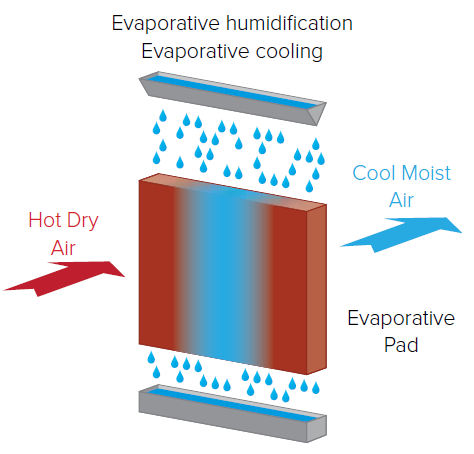Advantages of adiabatic cooling

Advantages of adiabatic cooling
I. Introduction
A. Definition of Adiabatic Cooling
II. The Environmental Benefits of Adiabatic Cooling
A. Reduction of energy consumption
B. Reduced production of greenhouse gases
C. Improved air quality
D. Improved thermal comfort
III. The economic advantages of adiabatic cooling
IV. The Armstrong EvaPackTM Humidifier/Cooler
I. Introduction
A. Definition of Adiabatic Cooling
The principle of adiabatic cooling is based on the first principle of thermodynamics, which defines energy transfers and transformations between an initial state and a final state: the total energy of an isolated system is conserved in all the transformations it undergoes.
Specifically, in air conditioning, when water molecules come into contact with air, the energy required to evaporate them is extracted from the air, which is then cooled and humidified. This technique is also known as “bioclimatisation”, “evaporative air cooling” or “natural air conditioning”.
Adiabatic cooling is often observed in nature, particularly when air passes over a body of water and its temperature is immediately reduced.
Evaporation is a phenomenon that occurs on the free water surface and converts water from liquid to gas phase.
« Only pure water is evaporated […] »
II. The environmental advantages of adiabatic cooling
A. Significant reduction of energy consumption
In air conditioning, the use of an adiabatic cooling system offers a less energy-intensive alternative to conventional air conditioning systems that use heat exchangers coupled to refrigerant compressors to cool the air.
B. Improved indoor air quality: Adiabatic coolers humidify the air, which can improve indoor air quality by reducing the volatility of dust particles, pollen and other allergens.
C. Environmentally friendly: Adiabatic coolers do not use refrigerant gas, which is often harmful to the environment, and do not produce greenhouse gases.
D. Environmentally-friendly: adiabatic coolers use no refrigerant gas, which is often harmful to the environment, and produce no greenhouse gases.
III. The economic advantages of adiabatic cooling
Adiabatic cooling offers a number of economic benefits, including
A. Improved energy efficiency: Adiabatic cooling improves energy efficiency by reducing the energy required for cooling, thus saving energy.
B. Low cost: Adiabatic coolers are easy to integrate into an air handling unit or ductwork with low installation costs.
C. Reduced maintenance costs: Adiabatic cooling combined with the use of demineralized water reduces maintenance costs as it requires very little maintenance and very few spare parts.
The adiabatic system can therefore be effectively integrated into a site’s decarbonization strategy, replacing a traditional system using chillers (refrigerant compressors) for cooling and gas-fired boilers for steam humidification.
IV. The Armstrong EvaPackTM Humidifier/Cooler
A pioneer in the development of humidity control systems for over 80 years, Armstrong International uses its expertise to meet the needs of commercial and industrial professionals.
Together with its subsidiary Devatec, it has developed one of its best-selling products, EvaPack™, designed to provide the highest possible air/water contact surface (up to 12% more efficient than conventional humidifiers) and guaranteed to meet the market’s most rigorous hygiene requirements.
Its role is to humidify and cool the air passing through its media without consuming energy.

Key benefits:
- customized units
- VDI 6022, RoHS and ISO 846 certifications
- no loss of VOCs (Volatile Organic Compounds) or fibers to the air
- no absorption distance
- exceptional efficiency
- energy savings.
- non-combustible (Euro Class A1)
- very low maintenance costs


Recent Comments